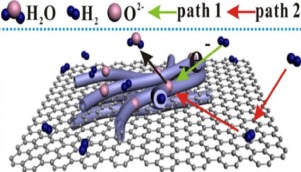当前位置:
X-MOL 学术
›
J. Ind. Eng. Chem.
›
论文详情
Our official English website, www.x-mol.net, welcomes your
feedback! (Note: you will need to create a separate account there.)
Investigation of hydrogen sensing properties of graphene/Al-SnO 2 composite nanotubes derived from electrospinning
Journal of Industrial and Engineering Chemistry ( IF 5.9 ) Pub Date : 2018-07-01 , DOI: 10.1016/j.jiec.2018.03.001 Seshendra Reddy Ch. , Liwen Zhang , Yejun Qiu , Yanan Chen , Sivasankar Reddy A. , Sreedhara Reddy P. , Sreekantha Reddy Dugasani
Journal of Industrial and Engineering Chemistry ( IF 5.9 ) Pub Date : 2018-07-01 , DOI: 10.1016/j.jiec.2018.03.001 Seshendra Reddy Ch. , Liwen Zhang , Yejun Qiu , Yanan Chen , Sivasankar Reddy A. , Sreedhara Reddy P. , Sreekantha Reddy Dugasani

|
Abstract Graphene-based device/sensor made of multifunctional nanomaterials is an emerging technology due to its huge impact on the engineering materials. Herein, we report the synthesis of pristine SnO2, Al-doped SnO2 (Al–SnO2), and graphene-embedded Al–SnO2 (G–Al–SnO2) nanotubes by one-step electrospinning method and studied their physical and gas sensing characteristics. The synthesized tubular structure was confirmed by scanning electron microscope (SEM) and transmission electron microscope (TEM). Structural, chemical binding, pore size, and chemical composition/elemental states were estimated by the X-ray diffraction, Raman, BET, and X-ray photoelectron spectroscopy, respectively. The performance of the gas sensing based on SnO2, Al–SnO2, and G–Al–SnO2 materials for H2 detection was investigated, and the G–Al–SnO2 composite nanotubes exhibit the superior sensitivity at 300 °C. The sensing response reaches about 23.8 at H2 concentration of 100 ppm with a shorter response time of about 2.2 s and recovery time of about 1.4 s. The gas sensing performance of the G–Al–SnO2 nanotubes is much better than that of the pristine SnO2 and Al–SnO2 nanotubes, which is probably attributed to the relatively smaller diameter of about 100 nm, better thermal and electronic conductivity, and relatively high oxygen vacancy, induced by graphene and Al-doping. The prepared H2 sensor is a simple, compact and highly sensitive, which holds high promising in many fields.
中文翻译:

静电纺丝石墨烯/Al-SnO 2 复合纳米管的氢传感性能研究
摘要 由多功能纳米材料制成的石墨烯基器件/传感器因其对工程材料的巨大影响而成为一项新兴技术。在此,我们报告了通过一步静电纺丝法合成原始 SnO2、Al 掺杂 SnO2 (Al-SnO2) 和石墨烯嵌入的 Al-SnO2 (G-Al-SnO2) 纳米管,并研究了它们的物理和气敏特性。通过扫描电子显微镜(SEM)和透射电子显微镜(TEM)确认合成的管状结构。结构、化学结合、孔径和化学成分/元素状态分别通过 X 射线衍射、拉曼、BET 和 X 射线光电子能谱估计。研究了基于 SnO2、Al-SnO2 和 G-Al-SnO2 材料的气体传感性能,用于检测 H2,G-Al-SnO2 复合纳米管在 300 °C 下表现出优异的灵敏度。感测响应在 H2 浓度为 100 ppm 时达到约 23.8,响应时间较短,约为 2.2 秒,恢复时间约为 1.4 秒。G-Al-SnO2 纳米管的气敏性能比原始的 SnO2 和 Al-SnO2 纳米管好得多,这可能是由于其直径相对较小,约为 100 nm,具有更好的导热和电子导电性,以及相对较高的氧空位,由石墨烯和铝掺杂引起。制备的 H2 传感器简单、紧凑且灵敏度高,在许多领域都具有很高的应用前景。G-Al-SnO2 纳米管的气敏性能比原始的 SnO2 和 Al-SnO2 纳米管好得多,这可能是由于其直径相对较小,约为 100 nm,具有更好的导热和电子导电性,以及相对较高的氧空位,由石墨烯和铝掺杂引起。制备的 H2 传感器简单、紧凑且灵敏度高,在许多领域都具有很高的应用前景。G-Al-SnO2 纳米管的气敏性能比原始的 SnO2 和 Al-SnO2 纳米管好得多,这可能是由于其直径相对较小,约为 100 nm,具有更好的导热和电子导电性,以及相对较高的氧空位,由石墨烯和铝掺杂引起。制备的 H2 传感器简单、紧凑且灵敏度高,在许多领域都具有很高的应用前景。
更新日期:2018-07-01
中文翻译:

静电纺丝石墨烯/Al-SnO 2 复合纳米管的氢传感性能研究
摘要 由多功能纳米材料制成的石墨烯基器件/传感器因其对工程材料的巨大影响而成为一项新兴技术。在此,我们报告了通过一步静电纺丝法合成原始 SnO2、Al 掺杂 SnO2 (Al-SnO2) 和石墨烯嵌入的 Al-SnO2 (G-Al-SnO2) 纳米管,并研究了它们的物理和气敏特性。通过扫描电子显微镜(SEM)和透射电子显微镜(TEM)确认合成的管状结构。结构、化学结合、孔径和化学成分/元素状态分别通过 X 射线衍射、拉曼、BET 和 X 射线光电子能谱估计。研究了基于 SnO2、Al-SnO2 和 G-Al-SnO2 材料的气体传感性能,用于检测 H2,G-Al-SnO2 复合纳米管在 300 °C 下表现出优异的灵敏度。感测响应在 H2 浓度为 100 ppm 时达到约 23.8,响应时间较短,约为 2.2 秒,恢复时间约为 1.4 秒。G-Al-SnO2 纳米管的气敏性能比原始的 SnO2 和 Al-SnO2 纳米管好得多,这可能是由于其直径相对较小,约为 100 nm,具有更好的导热和电子导电性,以及相对较高的氧空位,由石墨烯和铝掺杂引起。制备的 H2 传感器简单、紧凑且灵敏度高,在许多领域都具有很高的应用前景。G-Al-SnO2 纳米管的气敏性能比原始的 SnO2 和 Al-SnO2 纳米管好得多,这可能是由于其直径相对较小,约为 100 nm,具有更好的导热和电子导电性,以及相对较高的氧空位,由石墨烯和铝掺杂引起。制备的 H2 传感器简单、紧凑且灵敏度高,在许多领域都具有很高的应用前景。G-Al-SnO2 纳米管的气敏性能比原始的 SnO2 和 Al-SnO2 纳米管好得多,这可能是由于其直径相对较小,约为 100 nm,具有更好的导热和电子导电性,以及相对较高的氧空位,由石墨烯和铝掺杂引起。制备的 H2 传感器简单、紧凑且灵敏度高,在许多领域都具有很高的应用前景。











































 京公网安备 11010802027423号
京公网安备 11010802027423号